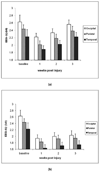Differential effect of first versus second concussive episodes on wavelet information quality of EEG
- PMID: 19375981
- PMCID: PMC2722913
- DOI: 10.1016/j.clinph.2009.03.009
Differential effect of first versus second concussive episodes on wavelet information quality of EEG
Abstract
Objective: Recent reports have suggested that long-term residual brain dysfunctions from mild traumatic brain injury (MTBI) that are often overlooked by clinical criteria may be detected using advanced research methods. The aim of the present study was to examine the feasibility of EEG wavelet information quality measures (EEG-IQ) in monitoring alterations of brain functions as well as to determine the differential rate of recovery between the first and second concussive episodes.
Methods: Student-athletes at high risk for MTBI (n=265) were tested prior to concussive episodes as a baseline. From this subject pool, twenty one athletes who suffered from two concussive episodes within one athletic season and were tested on days 7, 14 and 21 post-first and second injuries using a within-subjects design. Specifically, EEG was recorded and processed using wavelet entropy (EEG-IQ) algorithm along with a battery of neuropsychological (NS) tests. Spatial distribution of EEG-IQ and its dynamics in conjunction with NS data were analyzed prior to and after MTBI.
Results: No neuropsychological deficits were present in concussed subjects beyond 7 days post-injury after first and second concussions. However, EEG-IQ measures were significantly reduced primarily at temporal, parietal and the occipital regions (ROIs) after first and especially after second MTBI (p<0.01) beyond 7 days post-injury. Rate of recovery of EEG-IQ measures was significantly slower after second MTBI compared to those after the first concussion (p<0.01).
Conclusions: EEG-IQ measures may reveal alterations in the brain of concussed individuals that are most often overlooked by current assessment tools. In this regard, EEG-IQ may potentially be a valuable tool for assessing and monitoring residual brain dysfunction in "asymptomatic" MTBI subjects.
Significance: The results demonstrate the potential utility of EEG-IQ measures to classify concussed individuals at various stages of recovery.
Figures




Similar articles
-
Application of a novel measure of EEG non-stationarity as 'Shannon- entropy of the peak frequency shifting' for detecting residual abnormalities in concussed individuals.Clin Neurophysiol. 2011 Jul;122(7):1314-21. doi: 10.1016/j.clinph.2010.12.042. Epub 2011 Jan 7. Clin Neurophysiol. 2011. PMID: 21216191 Free PMC article.
-
Differential rate of recovery in athletes after first and second concussion episodes.Neurosurgery. 2007 Aug;61(2):338-44; discussion 344. doi: 10.1227/01.NEU.0000280001.03578.FF. Neurosurgery. 2007. PMID: 17762746
-
Incorporating virtual reality graphics with brain imaging for assessment of sport-related concussions.Annu Int Conf IEEE Eng Med Biol Soc. 2011;2011:1383-6. doi: 10.1109/IEMBS.2011.6090325. Annu Int Conf IEEE Eng Med Biol Soc. 2011. PMID: 22254575
-
American Medical Society for Sports Medicine position statement: concussion in sport.Br J Sports Med. 2013 Jan;47(1):15-26. doi: 10.1136/bjsports-2012-091941. Br J Sports Med. 2013. PMID: 23243113 Review.
-
Concussion in athletics: ongoing clinical and brain imaging research controversies.Brain Imaging Behav. 2012 Jun;6(2):224-43. doi: 10.1007/s11682-012-9167-2. Brain Imaging Behav. 2012. PMID: 22669496 Review.
Cited by
-
Long-Term Changes in Brain Connectivity Reflected in Quantitative Electrophysiology of Symptomatic Former National Football League Players.J Neurotrauma. 2023 Feb;40(3-4):309-317. doi: 10.1089/neu.2022.0029. Epub 2022 Nov 23. J Neurotrauma. 2023. PMID: 36324216 Free PMC article.
-
Application of a novel measure of EEG non-stationarity as 'Shannon- entropy of the peak frequency shifting' for detecting residual abnormalities in concussed individuals.Clin Neurophysiol. 2011 Jul;122(7):1314-21. doi: 10.1016/j.clinph.2010.12.042. Epub 2011 Jan 7. Clin Neurophysiol. 2011. PMID: 21216191 Free PMC article.
-
Using concurrent gait and cognitive assessments to identify impairments after concussion: a narrative review.Concussion. 2018 Jan 19;3(1):CNC54. doi: 10.2217/cnc-2017-0014. eCollection 2018 Mar. Concussion. 2018. PMID: 30202596 Free PMC article. Review.
-
Postural control deficits identify lingering post-concussion neurological deficits.J Sport Health Sci. 2016 Mar;5(1):61-69. doi: 10.1016/j.jshs.2016.01.007. Epub 2016 Jan 11. J Sport Health Sci. 2016. PMID: 30356901 Free PMC article. Review.
-
Neuromuscular Control Deficits and the Risk of Subsequent Injury after a Concussion: A Scoping Review.Sports Med. 2018 May;48(5):1097-1115. doi: 10.1007/s40279-018-0871-y. Sports Med. 2018. PMID: 29453743 Free PMC article.
References
-
- Al-Nashash HA, Paul J, Ziai W, Hanley D, Thakor NV. Wavelet entropy for subband segmentation of EEG during injury and recovery. Ann Biomed Eng. 2003;31:653–658. - PubMed
-
- Al-Nashash HA, Thakor NV. Monitoring of global cerebral ischemia using wavelet entropy rate of change. IEEE Trans Biomed Eng. 2005;52(12):2119–2122. - PubMed
-
- Bluml S, Brooks W. Magnetic resonance spectroscopy of traumatic brain injury and concussion. In: Slobounov S, Sebastianelli W, editors. Foundations of sport-related brain injuries. New York: Springer Press; 2006. pp. 197–220.
-
- Cantu R. Concussion classification: ongoing controversy. In: Slobounov S, Sebastianelli W, editors. Foundations of sport-related brain injuries. New York: Springer Press; 2006. pp. 87–111.
-
- Cao C, Tutwiler R, Slobounov S. Automatic classification of athletes with residual functional deficits following concussion by means of EEG signal using support vector machine. IEEE Trans Neural Syst Rehabil Eng. 2008;16(4):327–335. - PubMed
Publication types
MeSH terms
Grants and funding
LinkOut - more resources
Full Text Sources
Medical
Miscellaneous

